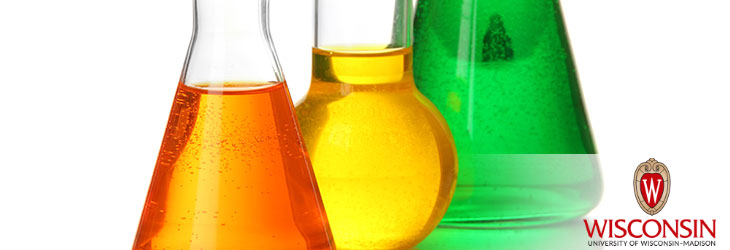Materials & Chemicals

Simplified Apparatus and Methods for Producing Nanoparticles in a Dense Fluid Medium
WARF: P06451US
Inventors: Ferencz Denes, Sorin Manolache, Hongquan Jiang
The Wisconsin Alumni Research Foundation (WARF) is seeking commercial partners interested in developing a simplified design for a dense medium plasma reactor.
Overview
Although many plasma reactions take place in the gas phase, reacting dense-phase (liquid) chemicals at atmospheric pressure and low temperature has advantages, including reduced power consumption and increased equipment longevity. A UW-Madison resarcher previously created a device for reacting dense-phase chemicals in an induced plasma state.
The Invention
UW-Madison resarchers have now developed a simplified design for the dense medium plasma (DMP) reactor, along with a method of using it to produce silicon, carbon and other nanoparticles. The improved DMP reactor includes a plasma reaction vessel with an internal reaction chamber into which a dense fluid medium may be introduced. An electrode assembly, consisting of two electrodes with opposing ring-shaped electrode discharge faces, is submerged in the fluid within the chamber. When an electric potential is applied, a plasma discharge zone forms between the opposing electrode discharge faces. A gas inlet port releases a cavitation gas into a zone between the electrodes, creating bubbles in the dense medium plasma. The bubbles replace the rotating electrode used to stir the fluid in the original reactor design. They promote the efficient, plasma-induced production of nanoparticles from precursors in the dense fluid medium.
Applications
- Semiconductor, metal and/or hybrid nanoparticles produced with this method may be used commercially in drug delivery or optical systems and as single-electron transistors, semiconductor lasers or markers for biological materials
Key Benefits
- Efficiently produces nanoparticles using a high-frequency, high-voltage electric field to react dense-phase precursors in an atmospheric-pressure, low-temperature environment
- Bubbles increase reaction efficiency.
- Bubble formation simplifies reactor design by eliminating the need for a rotating electrode to stir the dense fluid medium.
- Use of ring-shaped electrodes results in a separation between the exposed outer wall of the insulating portion of the inlet port and the discharge zone, minimizing erosion of the insulating member by the plasma discharge.
- Simplified reactor does not require rotating parts, glass-metal welding or rubber o-rings, making it simpler, cheaper and longer-lasting.
- Method does not require dangerous chemicals, such as metallic sodium or large quantities of toxic liquids.
- Safer than methods that use vapor forms of nanoparticle precursors
- Uses less energy than conventional, high-temperature gas-phase methods
- Processing takes place at room temperature
- Requires only small quantities of precursor materials
- Separation of metallic nanoparticles may be enhanced using a magnetic field.
- High-volume production in batch or continuous mode is feasible.
Stage of Development
This method was successful used to fabricate silicon and carbon nanoparticles.
For current licensing status, please contact Michael Carey at [javascript protected email address] or 608-960-9867